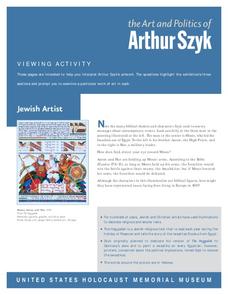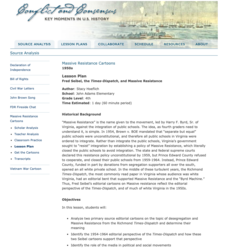Library of Congress
The Emancipation Proclamation and the Thirteenth Amendment
How did the Emancipation Proclamation lead to the Thirteenth Amendment? Middle schoolers analyze primary source documents including the text of the Emancipation Proclamation, political cartoons, photographs, and prints to understand the...
University of Pennsylvania
Using Political Postcards to Teach a Revolution of Political Thought
Discuss how political postcards affected everyday people's thoughts and beliefs. Pupils continue a unit on the Dreyfus Affair as they engage in class discussion, watch a video, view a PowerPoint presentation, and fill out worksheets to...
US Holocaust Museum
The Art and Politics of Arthur Szyk
Have you ever listened to a song that had a deeper political meaning to it? Every examined a work of art with layers of meaning? Pupils analyze the drawings of Arthur Szyk. They research the deeper meaning of several artistic cartoons...
Curated OER
The Way Editorial Cartoons Work
Twelfth graders interpret visual language found in political cartoons.
Curated OER
Interpreting Primary Sources: Cartoons
In this analyzing primary sources worksheet, students examine 3 political cartoons of their choice and respond to 4 short answer questions regarding each of them.
Curated OER
Cartoons for the Classroom: What's Replacing Our Newspapers?
In this current events worksheet, students analyze a political cartoon about the changing newspaper industry and respond to 3 talking point questions.
Curated OER
Cartoons for the Classroom: Mosque Debate
In this current events worksheet, students analyze a political cartoon about the New York City Mosque Debate and respond to 3 talking point questions.
Curated OER
Paul Conrad's Perspective on Civil Rights
Students review a political cartoon and discuss desegregation. In this cartoon analysis lesson, 11th graders discuss the impact of a political cartoon and its relation to a Supreme Court case. Students read additional information and...
Curated OER
A Picture is Worth a Thousand Words: Public Views of Lincoln
Students write a letter in the voice of Abraham Lincoln. In this history lesson, students interpret the way the public viewed Lincoln during various times by examining political cartoons and images. Students write a letter in the voice...
Roy Rosenzweig Center for History and New Media
Fred Seibel, the Times-Dispatch, and Massive Resistance
A lesson plan challenges scholars to analyze editorial cartoons created by Fred Seibel, illustrator for the Times-Dispatch, during the Massive Resistance. A class discussion looking at today's editorial pages and Jim Crow Laws leads the...
PBS
Using Primary Sources: Wide Open Town
A picture speaks a thousand words, no matter how old! Scholars use political cartoons from the era of Prohibition and the Temperance Movement to analyze what, a primary document (in this case, a bootlegger's notebook) is telling them...
Curated OER
"Reading" Political Cartoons"
Young scholars recognize visual sterotyping in political cartoons and to analyze its use. They speculate as to why political cartoons are so effective. The teacher explains that cartoonists often make use of stereotypes as visual...
Curated OER
Cartoons for the Classroom: Midterm Elections of 2010
In this current events learning exercise, students analyze a political cartoon about the midterm elections of 2010 and respond to 3 talking point questions.
Curated OER
Cartoons for the Classroom: Between the Lines, Debt Crisis
In this European debt crisis activity, students analyze a political cartoon about Greek debt and respond to 3 talking point questions.
Curated OER
Cartoons for the Classroom: 2011 Pulitzer Prize
In this current events worksheet, students analyze a political cartoon about the 2011 Pulitzer Prize and respond to 3 talking point questions.
Curated OER
Cartoon Analysis
In this current events activity, students analyze political cartoons of their choosing and respond to 16 analysis questions about the cartoons.
Curated OER
Cartoons for the Classroom: Unemployment
In this current events worksheet, students analyze a political cartoon about unemployment and respond to 3 talking point questions.
Curated OER
Cartoons for the Classroom: Vanishing Newspapers
In this current events worksheet, students analyze a political cartoon about the changing newspaper industry and respond to 3 talking point questions.
Curated OER
Cartoons for the Classroom: Obama Baggage
In this current events worksheet, high schoolers analyze a political cartoon about President Obama and respond to 3 talking point questions.
Curated OER
Cartoons for the Classroom: The Internet Continues to Change the Game
In this current events worksheet, students analyze a political cartoon about the influence of the Internet and respond to 3 talking point questions.
Curated OER
Cartoons for the Classroom: China's Censorship
In this current events worksheet, students analyze a political cartoon about Chinese censorship and respond to 3 talking point questions.
Curated OER
Cartoons for the Classroom: The Angry Election
In this election of 2010 learning exercise, students analyze a political cartoon about the Tea Party and respond to 3 talking point questions.
Curated OER
Cartoon and Political Poster Analysis
Students explore the late 1800s as a time of demographic change in the US. They view the role of media during this time in the form of posters and political cartoons. They create a political poster/cartoon that deals with current...
EngageNY
Building Background Knowledge: The Internment of Japanese-Americans during WWII, Part 4
Learners use a Analyzing Mediums handout to detail the advantages and disadvantages of communicating with mediums such as artwork, photographs, and political cartoons in the Japanese-American Internment during World War II primary...

























